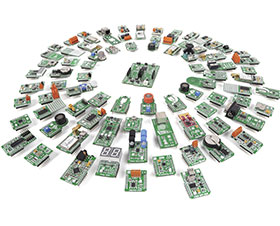

MikroElektronika’s ‘click’ boards are small extension boards with a standardised pinout conforming to the company’s mikroBUS portfolio. Offering easy hardware expandability and rapid prototyping for embedded developers, the expanding range currently comprises over 100 click boards, with new ones being added almost weekly.
Each board comes with a single module; these vary from sensors to displays, audio to motor control, communication to GPS, and even speech recognition. Included among them are modules from Microchip, bluegiga, u-blox, Telit and FTDI.
The boards can be wired up to almost any development hardware, and the inclusion of a mikroBus socket simplifies integration even further – developers can just plug a click board into the socket, instantly connecting it to the target development platform without having to perform any additional hardware modifications.
MikroElektronika’s latest generation of PIC, ARM, AVR and FT90x development boards carry mikroBUS host sockets; the company also offers a line of simple shields that add mikroBUS connectivity to today’s popular development platforms like Raspberry Pi, BeagleBone, LaunchPad, Discovery or Arduino. Code examples are published for each click board. Posted on the www.libstock.com coder’s community, they are written for all three MikroE compilers: mikroC, mikroBasic and mikroPascal.
The pinout comprises two 1x8 female headers containing pins (including SPI, I²C and UART) which are most likely to be used by the many different modules found on the 100+ click boards. The mikroBUS pinout and the click board ecosystem are especially suitable for developers who are working on multi-purpose, modular products like industrial controllers, home automation systems or educational tools that can be easily repurposed for different needs by adding a different set of sensors.
Since mikroBUS is an open standard, the potential of click boards goes beyond MikroElektronika’s own development ecosystem. Third-party developers are also incorporating mikroBUS sockets in their designs, adding click board connectivity for Microsoft’s .NET Micro Framework, Gadgeteer, Cypress and other platforms.
The offering varies from the tried-and-tested to new and exciting technologies: RS232 click being an example of the former, and LDC1000 click – which features the award winning, world’s first inductance-to-digital converter IC from Texas Instruments – being an example of the latter.
For more information contact Dizzy Enterprises, +27 (0)11 022 5323, [email protected], www.dizzy.co.za
| Tel: | +27 11 022 5323 |
| Email: | [email protected] |
| www: | www.dizzy.co.za |
| Articles: | More information and articles about Dizzy Enterprises |

© Technews Publishing (Pty) Ltd | All Rights Reserved